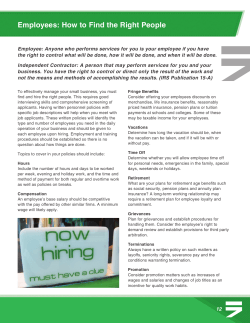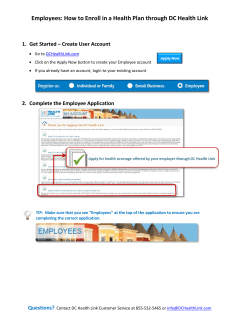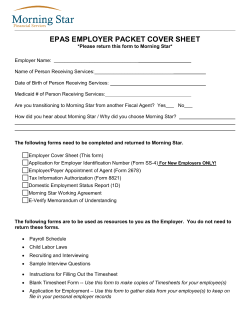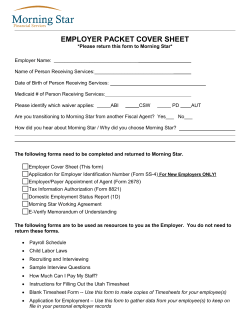
Laws Affecting the Workplace 2009 VASWCD Annual Meeting
Laws Affecting the Workplace 2009 VASWCD Annual Meeting Laws Affecting the Workplace There are a wide variety of laws encompassing the workplace affecting pay, benefits, severance, retirement, hiring, discrimination, retaliation and safety. In addition there are laws to protect employee and employer rights. Which of these is NOT a Federal Law? Equal Employment Opportunity Fair Labor Standards Act Smoke Free Workplace Act Occupational Safety & Health Act Family Medical Leave Act Workers Compensation Act Uniformed Services Employment and Redemption Rights Act Smoke Free Workplace Act There is no act or law in Virginia mandating a smoke free workplace; however, the Virginia Dept of Health has a website with tools to promote smoke free places including one new law for restaurants. VDH also has information to encourage Smoke-free indoor environments which can lead to: Lower maintenance expenses (carpets, drapes, cloths, paintwork). Lower insurance premiums (fire, medical, workers comp, liability). Lower labor costs (absenteeism, productivity). Mandatory Posters Many state and federal laws require that employers place required posters in where employees or potential employees can readily see them. There are fines associate with failure to post the required notices. There are online resources for free posters. http://www.doli.virginia.gov/publications/required_posters.html http://www.dol.gov/elaws/posters.htm The following are required Federal Posters: The Employee Polygraph Protection Act (EPPA) The Fair Labor Standards Act (FLSA) The Family and Medical Leave Act (FMLA) Uniformed Services Employment and Reemployment Rights Act (USERRA) The following are required Virginia Posters: Occupational Safety and Health: Job Safety and Health Protection Unemployment Insurance: Notice to Workers (VEC-B-29) Workers Compensation Insurance: Workers' Compensation Notice (VWC 1) Employer Earned Income Tax Credit Poster Employer Virginia Credit For Low-Income Individuals Poster Fair Labor Standards Act Fair Labor Standards Act originated in 1938 to provide for the establishment of fair labor standards in employments in and affecting interstate commerce, and for other purposes. The U S Department of Labor’s Wage & Hour Division has in depth information on this law. Fair Labor Standards Act continued The purpose is to assure that employees entitled to overtime for hours worked over 40 are paid at time and one-half. There are tests provided to determine if employees are exempt from overtime. The exemptions are for learned professional, executive, administrative, creative professional, computer professional and outside sales. Fair Labor Standards Act continued The test that will most likely be used in your offices is the Administrative Exemption: “The salary-basis test applies to the administrative exemption. Under this exemption, the primary duty must be non-manual work related to management or general business operations with the exercise of discretion and independent judgment in matters of significance to the business. So what does it mean to exercise discretion? Powell said an employee with discretion should have the ability to compare and evaluate options and choices in business decisions and be involved in the choices, which have to be significant. Whether white or off-white stationery should be purchased “will not get it,” he remarked. The administrative exemption often is used for jobs in HR, accounting and marketing and for other jobs “of that nature that run the business as a whole.” Fair Labor Standards Act continued Administrative Exemption To qualify for the administrative employee exemption, all of the following tests must be met: • The employee must be compensated on a salary or fee basis (as defined in the regulations) at a rate not less than $455 per week; • The employee’s primary duty must be the performance of office or non-manual work directly related to the management or general business operations of the employer or the employer’s customers; and • The employee’s primary duty includes the exercise of discretion and independent judgment with respect to matters of significance. Fair Labor Standards Act continued Overtime Pay vs. Compensatory Time Unlike private entities, a public agency, including a city, political subdivision may provide compensatory time off (comp time) in lieu of overtime payments IF a policy is in place prior to the employee performing any work. Fair Labor Standards Act continued (o) Compensatory time (1) Employees of a public agency which is a State, a political subdivision of a State, or an interstate governmental agency may receive, in accordance with this subsection and in lieu of overtime compensation, compensatory time off at a rate not less than one and one-half hours for each hour of employment or which overtime compensation is required by this section. Family Medical Leave Act (a) An employer covered by FMLA is any person engaged in commerce or in any industry or activity affecting commerce, who employs 50 or more employees for each working day during each of 20 or more calendar workweeks in the current or preceding calendar year. Employers covered by FMLA also include any person acting, directly or indirectly, in the interest of a covered employer to any of the employees of the employer, any successor in interest of a covered employer, and any public agency. Public agencies are covered employers without regard to the number of employees employed. Family Medical Leave Act continued • Provides eligible employees with up to 12 weeks of unpaid family or medical leave because of the birth of a child or the placement of a child with the employee for adoption or foster care, because the employee is needed to care for a family member (child, spouse, or parent) with a serious health condition, or because the employee's own serious health condition makes him or her unable to do his or her job. Your job is protected while you are out. • In general, to be eligible an employee must have worked for an employer for at least 12 months, have worked at least 1,250 hours in the 12 months preceding the leave, and work at a site with at least 50 employees within 75 miles. Equal Employment Opportunity There are many laws relating to Equal Employment Opportunity. The EEO itself, I-9’s or Employment Eligibility Verification, Americans with Disabilities Act, Age Discrimination, Race-Color-Religion-SexNational Origin, and newest Genetics. Each of these requires employers to post the appropriate posters. Statements need to be included in recruitment advertisements. EEO RACE, COLOR, RELIGION, SEX, NATIONAL ORIGIN Title VII of the Civil Rights Act of 1964, as amended, protects applicants and employees from discrimination in hiring, promotion, discharge, pay, fringe benefits, job training, classification, referral, and other aspects of employment, on the basis of race, color, religion, sex (including pregnancy), or national origin. Religious discrimination includes failing to reasonably accommodate an employee’s religious practices where the accommodation does not impose undue hardship. EEO DISABILITY Title I and Title V of the Americans with Disabilities Act of 1990, as amended, protect qualified individuals from discrimination on the basis of disability in hiring, promotion, discharge, pay, fringe benefits, job training, classification, referral, and other aspects of employment. Disability discrimination includes not making reasonable accommodation to the known physical or mental limitations of an otherwise qualified individual with a disability who is an applicant or employee, barring undue hardship. EEO AGE The Age Discrimination in Employment Act of 1967, as amended, protects applicants and employees 40 years of age or older from discrimination based on age in hiring, promotion, discharge, pay, fringe benefits, job training, classification, referral, and other aspects of employment. EEO SEX (WAGES) In addition to sex discrimination prohibited by Title VII of the Civil Rights Act, as amended, the Equal Pay Act of 1963, as amended, prohibits sex discrimination in the payment of wages to women and men performing substantially equal work, in jobs that require equal skill, effort, and responsibility, under similar working conditions, in the same establishment. EEO GENETICS NEW Title II of the Genetic Information Nondiscrimination Act of 2008 protects applicants and employees from discrimination based on genetic information in hiring, promotion, discharge, pay, fringe benefits, job training, classification, referral, and other aspects of employment. GINA also restricts employers’ acquisition of genetic information and strictly limits disclosure of genetic information. Genetic information includes information about genetic tests of applicants, employees, or their family members; the manifestation of diseases or disorders in family members (family medical history); and requests for or receipt of genetic services by applicants, employees, or their family members. EEO RETALIATION All of these Federal laws prohibit covered entities from retaliating against a person who files a charge of discrimination, participates in a discrimination proceeding, or otherwise opposes an unlawful employment practice. EEO I-9 Employment Eligibility Verification This poster is not mentioned on the DOL and VDOL websites, but it is a mandatory form for hiring and posting. This administration has made it clear that audits will be done. The I-9 form is mandated by the US Department of Homeland Security in order to verify an individual’s eligibility to work in the United States. It must be completed in two stages. 1. The employee must complete his/her part on the first day of work. 2. The employer must complete the verification by the 3rd workday. 1 2 3 List A List A includes documents that verify both identity AND employment eligibility. If a document from List A is provided, NO other documents are needed. List B AND List C List B and List C are used only if the employee does not have a document from List A. List B documents verify identity; List C docs verify employment eligibility. The employee must provide one item each from List B AND List C. Update and Information Sources 1. 2. Subscribe to: E-mail at DOL for updates www.theHRSpecialist.com
© Copyright 2025













